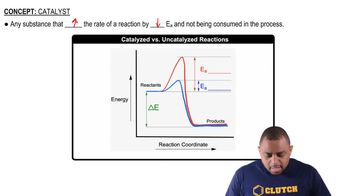Here are the essential concepts you must grasp in order to answer the question correctly.
Catalysts
A catalyst is a substance that increases the rate of a chemical reaction without being consumed in the process. It works by providing an alternative reaction pathway with a lower activation energy. In the context of the given reactions, identifying a catalyst involves recognizing any species that facilitates the conversion of reactants to products without undergoing permanent change.
Recommended video:
Catalyzed vs. Uncatalyzed Reactions
Intermediates
An intermediate is a species that is formed during the reaction and is consumed in subsequent steps. It exists only transiently and is not present in the overall balanced equation. In the provided reactions, identifying intermediates requires analyzing the sequence to find any molecules that appear in one step and are used up in another.
Recommended video:
Reaction Mechanism Example
Reaction Mechanism
A reaction mechanism is a detailed description of the steps involved in a chemical reaction, including the sequence of elementary reactions. Understanding the mechanism helps in identifying catalysts and intermediates, as it outlines how reactants are transformed into products. In this case, analyzing the two given reactions will reveal the roles of various molecules throughout the process.
Recommended video:
Reaction Mechanism Overview
 Verified step by step guidance
Verified step by step guidance

